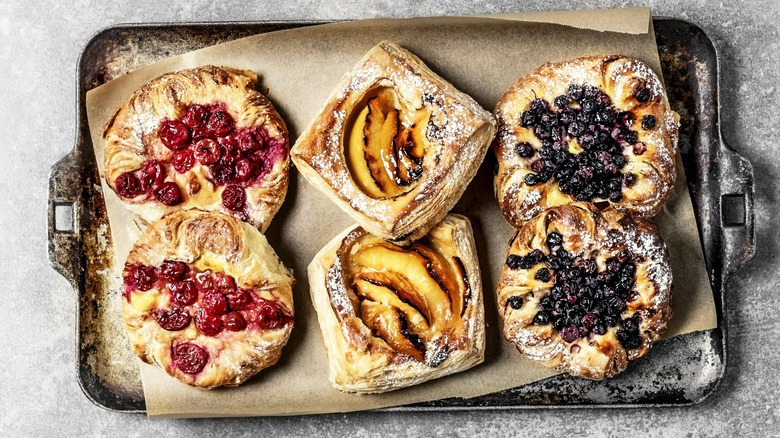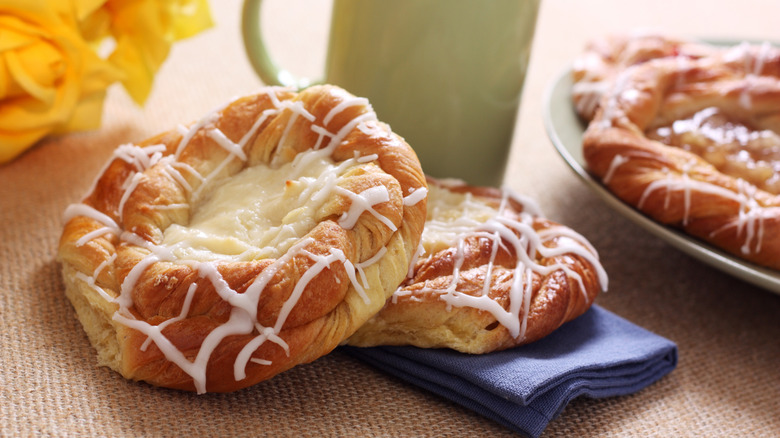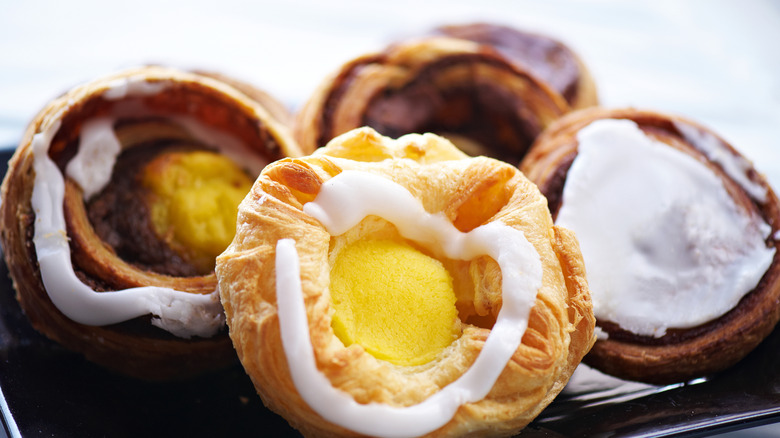We Call Them Danishes, But The Pastry's Real Name Points Outside Of Denmark
You'd be forgiven for thinking that Danish pastries are 100% Danish. After all, they're sold in bakeries across Denmark, stuffed with custard, drizzled with icing, and practically begging to be paired with coffee. But here's the twist: The pastry we call a "Danish" didn't actually originate in Denmark, it is simply a pastry lost in translation.
The flaky, buttery layers of this beloved treat can be traced back to Vienna, Austria, which is why, if you're in Denmark, you won't find locals ordering a "Danish" at the bakery. Instead, they call it "wienerbrød" or "Viennese bread." The name is a nod to the Austrian bakers who introduced laminated dough techniques to Denmark in the 19th century.
So how did this Viennese delight become so intertwined with Danish cuisine? And why do the rest of us call it a "Danish" while Denmark gives credit to Vienna? The answer, like the pastry itself, is a delicate, flaky mix of history, migration, and sweet, buttery luck.
How Austria baked its way Into Danish tradition
The history of Danish pastries begins not in Copenhagen, but in Vienna, where bakers had already perfected the art of laminated dough. These Austrian techniques involved layering butter into the dough to create the signature crisp, airy texture. But the real game-changer came in 1850 when a labor strike in Denmark forced bakeries to bring in foreign bakers, many of whom were from Austria and brought their own way of doing things.
These Austrian bakers introduced new pastry-making techniques that revolutionized Danish baking and changed it for good. Danish bakers slowly modified the original recipes given to them, adding more butter, eggs, and sugar to create a uniquely rich and flaky pastry. The result was a fusion of Austrian craftsmanship and Danish indulgence, giving birth to the pastry we now recognize as a Danish.
But in Denmark, it was never called a "Danish" at all. In fact, the locals named it "wienerbrød" or "Viennese bread" as a nod to its Austrian roots, and that name has not changed. Meanwhile, outside of Denmark, the name "Danish" stuck, probably because no one wanted to attempt pronouncing "wienerbrød" before their morning coffee, and we can't blame them. Over time, Danish bakers perfected the art of laminated dough, incorporating fillings like custard, jam, and almond paste that have now become synonymous with the pastry. If you're trying to make your own Vienna danishes at home, we have all the secrets to making perfect pastry cream, an essential ingredient in many Danish pastries.
How danishes took over the world
While Danish pastries became a staple in Denmark, they didn't gain international fame until a Danish immigrant named Lauritz C. Klitteng brought them to America in the early 20th century. Klitteng, who was a Danish baker, introduced "Danish pastry" to the U.S. at the 1915 Panama-Pacific Exposition in San Francisco. The rich, buttery treat was a hit, of course, and soon, the name "Danish" became the universal term for these pastries, even though their origins were more Austrian than Danish. Since then, Danish pastries have evolved into countless variations, from fruit-filled delights to the classic cheese Danish, which even McDonald's has taken a swing at. We reviewed their take on the McCafé cheese Danish, and let's just say that opinions were strong.
Of course, none of this would be possible without puff pastry, the foundation of all things flaky and golden. We would be remiss not to give you an easy way to make homemade puff pastry, proving that you don't need to be an Austrian baker to master the layers. So the next time you bite into a Danish, remember that it's really a piece of Viennese baking history. And if you ever find yourself in Denmark, don't ask for a Danish. Order a wienerbrød instead, and impress the locals with your pastry knowledge.


